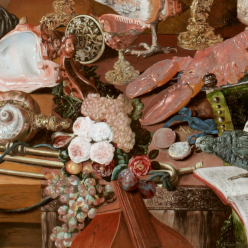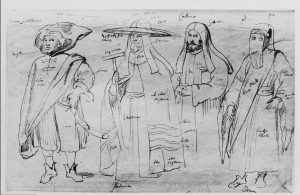![[n.d.]. Citron x sour orange, Citrus medica L. x Citrus aurantium L.: whole and half-fruits. https://library.artstor.org/asset/ARTSTOR_103_41822003813548.](/wp-content/uploads/2018/12/41822003813548-300x233.jpg)
Depicted is a watercolor painting of a citrus fruit, most likely a citron or sour orange, painted in the 17th century by the Italian artist, Cassiano Dal Pozzo. The image itself is nothing special, consisting of watercolors over black chalk and depicting a simple, anatomical diagram of a citrus fruit. Great detail is shown, with seed, pulp texture, coloration pattern, and irregularities all being paid careful attention. What is extraordinary about the drawing is not the image itself, but the socioeconomic and historical importance of its subject.
Citrus fruit was a crucial but often forgotten element of the transatlantic travel which made possible the discovery of the New World and the spread of colonialism. The events which occurred on account of citrus were an enormous step in the direction of modernity, eventually catalyzing major movements for social and political change such as the Enlightenment period and the rise of several great empires. The reason for citrus’ importance in oceanic travel is that it provided the most accessible and, at the time, most medically advanced cure for Scurvy, the disease which ravaged sea-faring crews in the 15th to 18th centuries, accounting for massive percentages of deaths at sea.
Scurvy itself was a disease which arose from a lack of vitamin C in the diet, a discovery which Europeans did not make until much later when the research of James Lind confirmed what was already known: that oranges and lemons prevent and remedy scurvy. Even without the scientific reasoning for the method, the effects of citrus became widely known by the end of the 15th century among European explorers. Records from the voyages of Portuguese explorer, Vasco de Gama, indicate not only an awareness of the disease, but a chaotic and ongoing struggle to cure it. This consisted of some ridiculous attempts such as the drinking of one’s own urine and bloodletting. Other famous explorers such as Christopher Columbus also directly reference scurvy in their reports, some reporting death rates greater than 80%.
When it was discovered that the cure for such a disparaging illness was so availably at hand, the implementation of citrus in the diets of sailors was immediate. Governments ensured the distribution of rations of oranges and lemons across naval crews in an effort to prevent the tragic and financially catastrophic loss of nearly entire crews. Before the death rate dropped and stabilized, governments of nations involved in the race for transatlantic exploration had become desperate enough to forcibly employ the residents of mental hospitals as naval crews. The discovery of the fruit was a relief to all. It is important, however, to note that citrus fruit back then was not what it is today. Citrons and lemons were the main source of citrus, both of which were bitter and unpleasant to consume. Sweet oranges were not introduced until later when citrus fruits became genetically modified to taste better. Thus the citrus which sailors were made to eat was little better than a spoonful of medicine would be today.
Bibliography
[n.d.]. Citron x sour orange, Citrus medica L. x Citrus aurantium L.: whole and half-fruits. https://library.artstor.org/asset/ARTSTOR_103_41822003813548.
Mayberry, Jason A. “Scurvy and Vitamin C.” Food and Drug Law, (2004): whole article.
Tiesler, Vera. “Scurvy‐related Morbidity and Death among Christopher Columbus’ Crew at La Isabela, the First European Town in the New World (1494–1498): An Assessment of the Skeletal and Historical Information.” (2014): whole article. https://docs.google.com/document/d/1LQkh6gRc3kL-PQhXGIu4skhDuBNS6VKQiS9X8iv1N0M/edit.
Earle, Rebecca. The Body of The Conquistador., New York: Cambridge University Press, 2012. Pg 54.
Lind, James. “A Treatise of the Scurvy, in Three Parts.” 1753. Accessed October 8, 2018. http://eds.a.ebscohost.com.avoserv2.library.fordham.edu/eds/detail/detail?vid=3&sid=02d66b2-8b8c-4746-8130-8c77e1c6da1f@sessionmgr4009&bdata=JnNpdGU9ZWRzLWxpdmU=#AN=ford.1080465&db=cat00989a.

